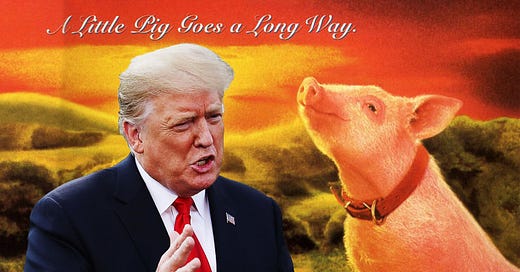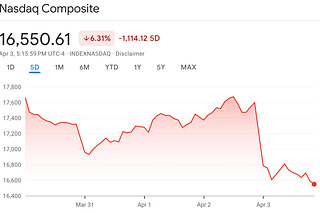
Galaxy Brain: Trump Plans to Solve World Hunger with Surplus Hog Feed
Another grand idea from America's stable genius.
Perhaps you’ve noticed by now that Donald Trump likes to make stuff up, from time to time. Every morning, the nation arises to a fresh heap of lies, misunderstandings, and outright fantasias already dispensed, mostly on Twitter, by our early-bird president. Off dash the fact-checkers and pencil-pushers in his wake, but it’s mostly a futile exercise—by the time they’ve punctured any given falsehood, he’s already off on some new riff, and away they must race again. And three years in, it's clear that they’re wearing themselves out faster than he is.
So prudence dictates that people interested in sussing out the president's fictions have to pick their battles. Sometimes, when the president pops off with a loony idea, you can just wince and wait for it to fade into the noise on its own. Remember when Trump suggested Antonin Scalia might have been murdered? Or that the Access Hollywood tape was faked? Or that Ted Cruz’s dad helped kill JFK? They basically disappeared on their own. Perhaps because Trump was only speaking literally. Or seriously. Or whatever.
But other times, alas, Trump’s spur-of-the-moment concoctions seem to lodge in his brain and fester, such that for days on end he can hardly discuss related issues without sidetracking himself by bringing them up. At such times, these brainstorms have a dangerous tendency to be suddenly transubstantiated from “momentary ad-lib” to “new federal policy.”
These are the ones to watch out for.
The most recent of the festerers cropped up over the weekend, involving the president’s ongoing trade war with China. The conflict has already begun to have serious economic consequences for America—particularly for farmers in the Corn Belt, who have in recent decades invested heavily in Chinese trade and have subsequently suffered heavy losses. Not to worry, however, as the president announced last Friday that he'd devised a solution: With all the money America was making on tariffs, the U.S. government was simply going to buy up the surplus product that’s no longer going to China—and send it to the Third World to feed the global poor!

It’s easy to see why the president finds this notion so appealing: It’s got the two-birds-with-one-stone quality that lunkheads who think themselves brilliant tacticians prize in ideas. (It also bears a striking resemblance to Trump’s hilarious years-ago explanation for why his adult sons should be applauded for their Bungalow Bill safari exploits, but there’s no need to dwell on that.) But unfortunately for Trump, farmers, and the Third World, the idea falls apart under the simplest scrutiny.
Two quotidian concerns present themselves at once. First, slapping tariffs on China does not force China to pay a massive windfall to the U.S. government—as the president’s own chief economic adviser acknowledged this weekend. In reality, it's American companies that are on the hook for the increased tax. Second, it's Congress, not the White House, that determines what to do with the money the government raises. But these are boring objections. To truly grasp the insanity of Trump’s farm plan, you have to look a little closer at the details of America’s agricultural relationship with China.
Over the last few decades, China’s rapid economic expansion has allowed hundreds of millions of people to escape extreme poverty, with the country’s poverty rate plummeting from 88 percent in 1981 to just 6.5 percent in 2012. That has meant richer, more well-rounded diets for hundreds of millions of Chinese people—and an increasing demand for agricultural imports, which U.S. farmers were in prime position to capitalize on.
But the international ag market operates a little differently from most commodity markets, for the obvious reason that most types of food, unlike most raw commodities, spoil very quickly. Most of what China began to import from the United States, then, wasn’t food for its citizens, but food for its food: vast quantities of U.S. grains to feed China’s newly massive herds of domestic pork. In the year 2017, American farmers sold $12.4 billion in soybeans to China, roughly a third of their total crop. No other food commodity even broke the $1 billion mark in exports.
As a result, it’s been soybean farmers who have so far born the brunt of the trade war, as exports they’ve built their businesses around dried up almost entirely last year under onerous Chinese tariffs. It’s soybeans—not wheat or meat or dairy products—that are piling up in farmers’ storage bins because prices have dropped too low to sell.
Soybeans, of course, do have their culinary uses: their extracted oil is used in any number of products, from margarine to salad dressing, and they can be rendered into bougie items like soy milk and tofu. But they’re not exactly the kind of grain that you hand over by the sackful to starving villagers with a “hey kid, eat this.” Trump’s grand plan to address both our farm woes and global hunger in one fell swoop is to ply the starving peoples of the world with our surplus hog feed.
“No one in the world is going to want raw soybeans,” farm economist Dan Basse told The Bulwark. “Of course, humans consume the soybean oil component—the rest, which is largely soy meal, would be for livestock.” Basse added that the proposed idea would also violate WTO rules.
By starting a trade war with China, Trump pulled the rug out from under U.S. farmers, cutting them off from a critical export market on which they’d come to rely. The longer the trade war goes on, the worse the damage to the industry will be. Even if it were to end tomorrow, much of the damage may well prove permanent: It’s impossible to know whether the U.S. will ever recapture their Chinese market share now that the Chinese have shifted their business to other providers. These are serious, complex problems, and ones which the president won’t be able to solve with a magic bullet—much less one as nonsensical as “Let them eat soybeans.”











